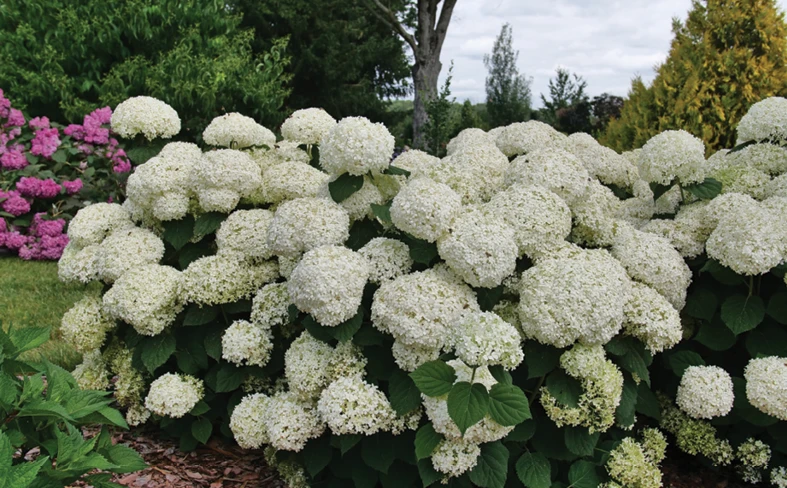| We asked growers across Georgia, Kentucky, North Carolina, South Carolina and Tennessee to share their experiences with scouting for pests and monitoring pest populations, the practices they have adopted for pest prevention and the actions they take to control pests at their operations. More than 200 growers took the Southern Nursery Integrated Pest Management team’s survey. Here is the summary of what was revealed about use of 10 key IPM practices. 10. Acknowledging general IPM use at grower’s nurseries. When growers were asked how frequently IPM practices were used at their respective nurseries, 16 percent said “Always” and 64 percent said “Often.” About 20 percent of growers stated they “Rarely” used IPM to produce the plants that generate their businesses’ profits. IPM offers advantages of a sustainable approach to managing pests by combining biological, cultural and chemical tools to minimize economic, health and environmental risks. To function efficiently, IPM requires dedication to scouting for, identifying, and monitoring pest populations. After selecting the best control options, growers should follow up to evaluate their management action’s effectiveness. 9. Sticky cards, ethanol traps, and lures. Whether these monitoring tools are used individually or in combination, these pest collection techniques help pinpoint adult pest emergence and pest population levels in and around production areas. Traps and lures are quick and easy to use by relatively untrained employees. Once deployed, trap counts can help growers schedule management actions including pesticide sprays. Yet only about 18 percent of growers report using these inexpensive monitoring tools. Granulate (=Asian) ambrosia beetles are readily attracted to ethanol traps and fly surprisingly early each season—typically following the first few consecutive spring days with air temperatures around 70°F. Spray programs timed to target adults at first emergence have successfully controlled this pest. 8. Bioprotectants are naturally occurring organisms or compounds that enhance a plant’s ability to defend against plant pathogens. These relatively new IPM options can help prevent presence and spread of pathogens in nurseries, though were used by just 12 percent of surveyed growers. Bioprotectants provide various modes of action and can be applied as granules, soil drenches and sprays. Several bioprotectants are commercially available for use in nurseries. Regalia SC (formally Milsana) manages powdery mildew and rust diseases on woody ornamental plants like Lagerstroemia and Rosa. Serenade MAX controls or suppresses plant diseases including leaf spot forming fungi (like Alternaria spp., Cercospora spp., Entomosporium spp., Helminthsporium spp., Myrothecium spp., and Septoria spp.), as well as Phytophthora spp. and anthracnose (Colletotrichum spp.) diseases. Actino Iron (Streptomyces lydicus) is a biological fungicide that colonizes the root systems of treated ornamental plants and helps suppress Pythium, Rhizoctonia, Fusarium, Phytophthora and Verticillium diseases in ornamentals. While these products may be too costly to use throughout the entire nursery, proactive growers may benefit by selectively treating valuable plants that are most susceptible to soil pathogens, including Rhododendron, Viburnum, Pieris and Camellia. 7. Quarantines and temporary isolation of incoming nursery stock. Although 90 percent of growers inspect their plants and liner purchases for pests when delivered, only 26 percent of growers provide a designated area to quarantine or isolate incoming nursery stock. Simply isolating incoming stock for two to four weeks, even stock from a well-known grower, reduces the risk that undetected plant diseases and insect pests will spread to other nursery plants. When a period of isolation cannot be set aside due to production scheduling, growers should closely inspect plant canopies, stems and roots both upon receipt and again two to four weeks into the production cycle to be sure visual signs and symptoms of diseases and insects remain absent. 6. Seasonal weed mapping provides growers a way to identify problem weeds and to better determine the point of weed origin and potential localized hot spots. Mapping key weed infestations and recording seasonal seed set information helps growers prioritize control activities and reduces herbicide use, yet only 8 percent of growers create or use weed maps to track weed spread. 5. Setting up irrigation zones for plant groups with similar water needs. More than 90 percent of growers reported that they group plants with similar water needs.  Figure 1. The (A) rigid block, (B) random walk, and (C) hot spot scouting diagrams used during integrated pest management programs. 4. Adopt a standardized sampling plan when scouting for pests and diseases. Figure 1. The (A) rigid block, (B) random walk, and (C) hot spot scouting diagrams used during integrated pest management programs. 4. Adopt a standardized sampling plan when scouting for pests and diseases. Growers that reported they scout for pests acknowledged that they most often recognize plant damage in a large block of plants while potting, fertilizing or preparing to ship. At this point, it may be too late to salvage a damaged crop in time for seasonal sales. Instead, the most efficient growers set aside a specific time, and even a dedicated employee, who will scout nursery stock at weekly or biweekly intervals throughout the production cycle. Growers can eliminate wasted effort by adopting one of three simple scouting plans: rigid block, random walk and hotspot scouting (Figure 1). The rigid block method allows growers to inspect almost every plant in the block, while the random walk bisects the planting area and gives a cursory look to about half the block with a close inspection of the other half. Hot spot scouting is best for areas that have been seasonal trouble spots, for example, stressed trees on the south west edge blocks that receive heavy wind. 3. Develop a working knowledge of key pests and plant diseases. A successful IPM program depends on correctly identifying the problems found during scouting. Growers we surveyed believed they would be able to correctly identify the pests (87 percent of growers) and plant diseases (84 percent of growers) they encountered. Just as important as identifying insect pests is identifying beneficial insect predators and natural enemies. Only 30 percent of growers determined if natural enemies are active within their nurseries during scouting. Visit www.nysaes.cornell.edu/ent/biocontrol/index.php for pictures of beneficial insects. 2. Take pictures and create a permanent record of nursery-specific scouting knowledge. By being your own crop monitor, or by employing a dedicated pest and disease scout, growers invest significant money toward monitoring crops. Each time trained employees quit, shift to a different job responsibility or retire, that invaluable nursery-specific knowledge is lost and training costs must be re-expended. Yet only 24 percent of growers took pictures of the disease and injury symptoms caused by pests and plant diseases, and just 33 percent kept permanent records of nursery scouting activities and management actions. 1. When in doubt, send it out. Send samples to plant diagnostic clinics. Growers reported sending a range of zero samples per year to nearly 30 samples per year to plant diagnostic clinics. Correct pest and disease identification is the cornerstone for efficient and effective IPM, and helps growers choose the best management option. |
Get curated news on YOUR industry.
Enter your email to receive our newsletters.Loading...

Explore the May 2011 Issue
Check out more from this issue and find your next story to read.







